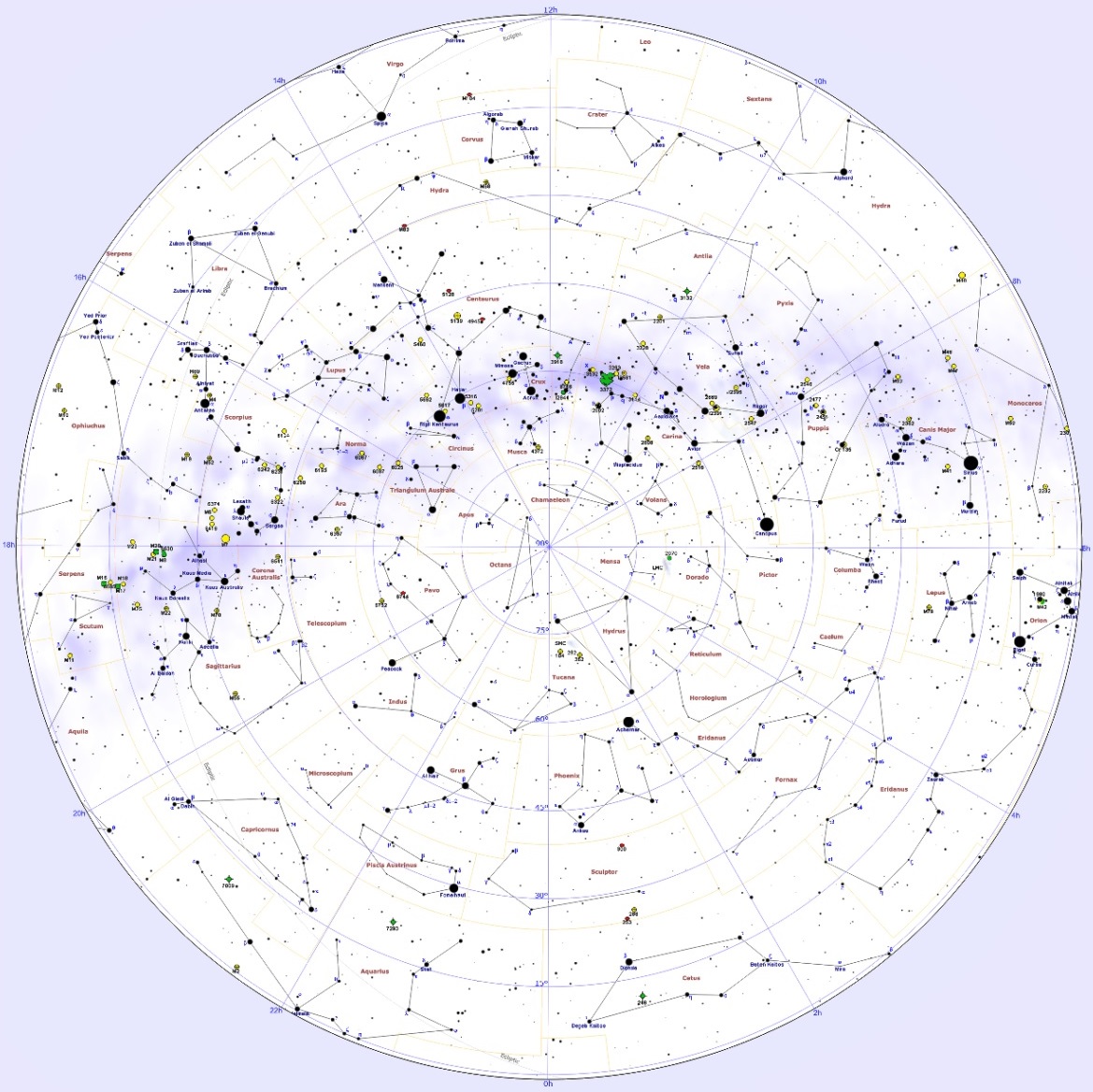Southern constellations are those that lie in the southern celestial hemisphere, south of the celestial equator. These constellations are best seen from the southern hemisphere, where they rise higher above the horizon in the night sky.
The southern constellations that were visible to the ancient Greeks are mostly associated with Greek myths. They were catalogued by the Greek astronomer Ptolemy in the 2nd century CE.
The ancient southern constellations include Centaurus (the Centaur), Canis Major (the Great Dog), Hydra (the Water Snake), Cetus (the Sea Monster), and the zodiac constellations Sagittarius (the Archer), Scorpius (the Scorpion), Virgo (the Maiden), and Aquarius (the Water Bearer).
Fifteen constellations lie on the celestial equator. The equatorial constellations that lie predominantly in the southern celestial hemisphere are Aquarius (the Water Bearer), Cetus (the Whale or Sea Monster), Eridanus (the River), Hydra (the Water Snake), Ophiuchus (the Serpent Bearer), Sextans (the Sextant), and Virgo (the Maiden).
Monoceros (the Unicorn) is assigned to the second quadrant of the northern hemisphere, but most of the constellation lies south of the celestial equator.
Hydra, the largest southern constellation, is the largest constellation in the sky. However, its stars are not particularly bright and the constellation does not stand out in the sky. In contrast, Crux (the Southern Cross) is the smallest constellation in the sky, but also one of the most recognizable ones because its constellation figure includes some of the brightest stars in the sky.
The constellations that were not visible to northern observers were not mapped until the late 16th century, when European navigators and explorers started going on expeditions that took them south of the equator.
The southern constellations include the entire Bayer family, a group of 11 constellations introduced by the German uranographer Johann Bayer in 1603.
These are Apus (the Bird of Paradise), Chamaeleon, Dorado (the Dolphinfish), Grus (the Crane), Hydrus (the Lesser Water Snake), Indus (the Indian), Musca (the Fly), Pavo (the Peacock), Phoenix, Tucana (the Toucan) and Volans (the Flying Fish).
Bayer acquired these constellations from the Flemish astronomer and cartographer Petrus Plancius, who had based his constellation map on the observations of the Dutch navigators Pieter Dirkszoon Keyser and Frederick de Houtman in the late 16th century.
The constellations in the Lacaille family, introduced by the French astronomer Nicolas Louis de Lacaille in 1756, are also all located in the southern celestial hemisphere. These are Antlia (the Air Pump), Caelum (the Chisel), Circinus (the Compass), Fornax (the Furnace), Horologium (the Pendulum Clock), Mensa (Table Mountain), Microscopium (the Microscope), Norma (the Level), Octans (the Octant), Pictor (the Painter’s Easel), Reticulum (the Reticle), Sculptor and Telescopium (the Telescope).
Lacaille created these constellations while observing the southern skies from an observatory on Table Mountain in South Africa. They were not visible to the ancient civilizations in Europe.
Lacaille also divided the Greek constellation Argo Navis (the Ship Argo) into three smaller constellations: Carina (the Keel), Puppis (the Stern), and Vela (the Sails). The smaller constellations are still in use today and are among the brighter southern constellations. Carina is home to Canopus, the second brightest star in the sky.
Octans, the southernmost constellation in the sky, hosts Polaris Australis (the South Star), the nearest visible star to the south celestial pole. Most of Octans never rises for observers in the northern hemisphere. Like many other southern constellations, Octans is small and faint. For this reason, observers use the bright stars of Crux to find true south.
The largest constellations in the southern celestial hemisphere are Hydra (1302.84 square degrees), Virgo (1294.43), Cetus (1231.41), Eridanus (1137.92), Centaurus (1060.42), Aquarius (979.85) and Ophiuchus (948.34).
The smallest southern constellations are Crux (68.45 square degrees), Circinus (93.35), Scutum (109.11), Triangulum Australe (109.98), Reticulum (113.94), Caelum (124.87) and Corona Australis (127.70).
Below is the list of the 52 southern constellations. The southern celestial hemisphere is divided into four quadrants – SQ1, SQ2, SQ3, and SQ4 – and the southern constellations lie within these quadrants.
Caelum (SQ1)
Cetus (SQ1)
Columba (SQ1)
Dorado (SQ1)
Eridanus (SQ1)
Fornax (SQ1)
Horologium (SQ1)
Hydrus (SQ1)
Lepus (SQ1)
Mensa (SQ1)
Phoenix (SQ1)
Pictor (SQ1)
Reticulum (SQ1)
Sculptor (SQ1)
Antlia (SQ2)
Canis Major (SQ2)
Carina (SQ2)
Chamaeleon (SQ2)
Crater (SQ2)
Hydra (SQ2)
Puppis (SQ2)
Pyxis (SQ2)
Sextans (SQ2)
Vela (SQ2)
Volans (SQ2)
Apus (SQ3)
Ara (SQ3)
Centaurus (SQ3)
Circinus (SQ3)
Corvus (SQ3)
Crux (SQ3)
Libra (SQ3)
Lupus (SQ3)
Musca (SQ3)
Norma (SQ3)
Ophiuchus (SQ3)
Scorpius (SQ3)
Triangulum Australe (SQ3)
Virgo (SQ3)
Aquarius (SQ4)
Capricornus (SQ4)
Corona Australis (SQ4)
Grus (SQ4)
Indus (SQ4)
Microscopium (SQ4)
Octans (SQ4)
Pavo (SQ4)
Piscis Austrinus (SQ4)
Sagittarius (SQ4)
Scutum (SQ4)
Telescopium (SQ4)
Tucana (SQ4)
